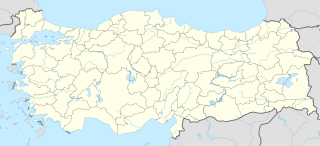Temple of Apollo can refer to:

Didyma was an ancient Greek sanctuary on the coast of Ionia and belonged to the famous city of Miletus. Apollo was the main deity of the sanctuary of Didyma, also called Didymaion. It contained temples for the twins Apollo and Artemis. Other deities were adorned within the sanctuary too. The Didymaion was well known in antiquity because of its oracle. This oracle of Apollo was situated within the world’s greatest temple for Apollo.

Monarda didyma is an aromatic herb in the family Lamiaceae, native to eastern North America from Maine west to Ontario and Minnesota, and south to northern Georgia. Its odor is considered similar to that of the bergamot orange. The scientific name comes from Nicolas Monardes, who described the first American flora in 1569.

Didim is a small town, popular seaside holiday resort, and district of Aydın Province on the Aegean coast of western Turkey, 123 km (76 mi) from the provincial capital city of Aydın. Didim is the site of the antique city of Didyma with its ruined Temple of Apollo.
Acacia didyma is a shrub or small tree which is native to Western Australia. It grows to between 1.5 metres and 4 metres in height and flowers from August to October in its native range.

Melitaea didyma, the spotted fritillary or red-band fritillary, is a butterfly of the family Nymphalidae.

Neverita is a genus of medium-sized to large sea snails, marine gastropod molluscs in the family Naticidae, the moon snails
Gemmuloborsonia didyma is a species of sea snail, a marine gastropod mollusk in the family Clavatulidae.
Torellia didyma is a species of small sea snail, a marine gastropod mollusk in the family Capulidae, the cap snails.

Neverita didyma, common name the bladder moon snail or moon shell, is a species of predatory sea snail, a marine gastropod mollusk in the family Naticidae, the moon snails.

The modius is a type of flat-topped cylindrical headdress or crown found in ancient Egyptian art and art of the Greco-Roman world. The name was given by modern scholars based on its resemblance to the jar used as a Roman unit of dry measure, but it probably does represent a grain-measure, and symbolized powers over fecundity in those wearing it.
Ropica is a genus of beetles in the family Cerambycidae, containing the following species:
Ropica ceylonica is a species of beetle in the family Cerambycidae. It was described by Breuning in 1939.
Ropica marmorata is a species of beetle in the family Cerambycidae. It was described by Breuning in 1939. It contains the subspecies Ropica marmorata marmorata and Ropica marmorata sarawakiana.
Ropica pseudosignata is a species of beetle in the family Cerambycidae. It was described by Breuning in 1939.
Ropica biroi is a species of beetle in the family Cerambycidae. It was described by Breuning in 1953.
Ropica sechellarum is a species of beetle in the family Cerambycidae. It was described by Breuning in 1957. It contains the subspecies Ropica sechellarum interruptefasciata and Ropica sechellarum sechellarum.
Ropica ignobilis is a species of beetle in the family Cerambycidae. It was described by Newman in 1842.
Ropica formosana is a species of beetle in the family Cerambycidae. It was described by Bates in 1866. It contains four subspecies, Ropica formosana formosana, Ropica formosana japonica, Ropica formosana nobuoi, and Ropica formosana tokaraensis.







